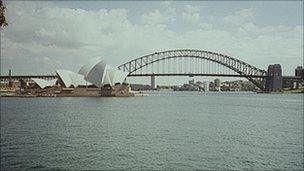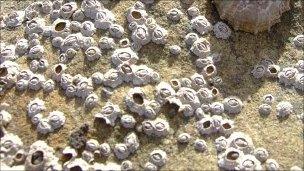Coastal structures design could help plants and animals
- Published

As well as structures in Devon and Cornwall, researchers examined Sydney Harbour
Changing the way sea walls, breakwaters, rock armour and jetties are designed could help Britain's coastline ecology.
Exeter and Plymouth universities have been working with environmental consultants to produce guidance for the design of coastal defence structures.
Researchers claim adding a rough surface to a concrete structure could help increase biodiversity.
The work has been carried out with the support of the Environment Agency (EA).
Previous research has indicated that hard coastal structures, unlike natural rocky shores, often support only a few opportunistic species, such as green algae.
'Valuable' guide
The research team not only examined structures across the South West coast, including Ilfracombe in Devon and Newlyn in Cornwall, but looked at Sydney Harbour in Australia and Seattle Harbour in the US.
They focused on organisms such as barnacles and limpets which dominate rocky shore environments and rapidly colonise hard surfaces, including harbour walls.
Once established, other plants and animals typically follow, to the benefit of species such as salmon.
Dr Larissa Naylor, from the University of Exeter, said small changes to the surface of new structures could improve the number and type of species colonising them.

Limpets and barnacles, which like rocky shores, attract other species
"Coastal defence structures are essential in protecting people, homes and businesses from flooding and erosion, however, they also impact on the biodiversity of our coastlines," she said.
"This will become even more important as these risks increase as a result of climate change and more hard coastal infrastructure is required in certain locations.
"We have shown that by making small changes, such as producing surfaces that are rough rather than smooth, or leaving niches in sea walls, we can ensure these structures support much more wildlife."
EA staff will look at the recommendations to consider how they could be used in future coastal developments.
'Economic benefit'
"This research is the first to consider the practical challenges of including enhancements into the planning, design and construction of rock and concrete coastal structures," EA spokesman David Baxter said.
"It provides a valuable guide to the techniques that are available and it will therefore be of great interest to those involved in coastal defence works including our own staff, local authority planners, marine regulators, contractors, environmental consultants and landowners."
Prof Richard Thompson, from Plymouth University, said the guidance would not only help the environment but could also have an economic benefit.
"This research not only establishes the viability of using engineered structures to enhance the field habitat for marine life, but it demonstrates the potential to boost stocks of commercially important shellfish using this approach."